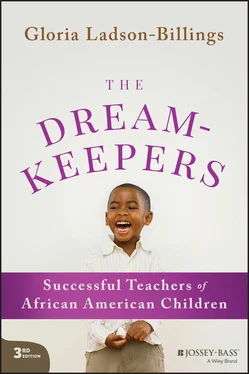I was sent to an integrated junior high school that was not in my neighborhood. I describe it as “integrated” rather than “desegregated” because no court mandates placed black children there. I was there because my mother was concerned about the quality of our neighborhood school .
There were a handful of African American students in my seventh-grade class, but I knew none of them. They lived in a more affluent neighborhood than I did. Their parents had stable blue collar or white collar jobs. They had gone to better-equipped elementary schools than I had. The white students were even more privileged. Their fathers had impressive jobs as doctors, lawyers—one was a photojournalist. Most of their mothers were homemakers. In contrast, my mother and father both worked full-time. My father often even worked two jobs, yet we still lived more modestly than most of my classmates did .
In seventh grade I learned what it means to be competitive. In elementary school my teachers did not seem to make a big deal out of my academic achievements. They encouraged me but did not hold me up as an example that might intimidate slower students. Although I suspect I was a recipient of a kind of sponsored mobility—perhaps because my mother always sent me to school neat and clean and with my hair combed—I don't think this preferential treatment was obvious to other students. But in my new surroundings the competition was very obvious. Many of my white classmates made a point of showing off their academic skills. Further, their parents actively lent a hand in important class assignments and projects. For example, one boy had horrible penmanship. You could barely read what he scrawled in class, but he always brought in neatly typed homework. I asked him once if he did the typing and he told me that his mother typed everything for him. She also did the typing for his cousin, who was also in our class and had beautiful penmanship. The teachers often commented on the high quality of these typed papers .
I had come from a school where children learned and produced together. This competitiveness, further encouraged by the parents, was new to me. I could attempt to keep up with this unfair competition and “act white” or I could continue to work my hardest and hope that I could still achieve .
A Study of Effective Teaching for African Americans
This book examines effective teaching for African American students and how such teaching has helped students not only achieve academic success but also achieve that success while maintaining a positive identity as African Americans. It is about the kind of teaching that promotes this excellence despite little administrative or collegial support. It is about the kind of teaching that the African American community has identified as having its children's best interests at heart. It is about the kind of teaching that helps students choose academic success.
This book is based on my study of successful teachers of African American students, which was funded by a 1988 postdoctoral grant from the National Academy of Education's Spencer Foundation. I conducted this research during the 1988–89 and 1989–90 school years, with an additional in-depth study of two classrooms in the 1990–91 school year. The opinions expressed in this publication do not necessarily reflect the position, policy, or endorsement of the National Academy of Education or of the Spencer Foundation.
I make a distinction between excellent teaching and excellent teachers purposely. Although each of the teachers who participated in my study are superb individually, this book looks at a teaching ideology and common behaviors, not at individual teaching styles. By choosing this path, I lose some of the distinctive and rich personal qualities of these marvelous individuals. However, I sacrifice this richness in favor of a focus on “the art and craft of teaching.” 42 This focus is important because it minimizes the tendency to reduce the research findings to individual idiosyncrasies and to suggest a “cult-of-personality” explanation for effective teaching. Looking carefully at the teaching, while offering the teachers as exemplars, provides a useful heuristic for teachers and teacher educators who wish to take on the challenge of being successful with African American students.
This book is about teaching practice, not about curriculum. Much of the purported reforms and the debate about our schools focuses on curriculum: What should we teach? Whose version of history should we offer? What priority should different subject matters be given? But it is the way we teach that profoundly affects the way that students perceive the content of that curriculum.
My notions in this domain are strongly aligned with Giroux and Simon's thoughts on critical pedagogy:
Pedagogy refers to a deliberate attempt to influence how and what knowledge and identities are produced within and among particular sets of social relations. It can be understood as a practice through which people are incited to acquire a particular “moral character.” As both a political and practical activity, it attempts to influence the occurrence and qualities of experiences. When one practices pedagogy, one acts with the intent of creating experiences that will organize and disorganize a variety of understandings of our natural and social world in particular ways … . Pedagogy is a concept which draws attention to the processes through which knowledge is produced. 43
Because of this pedagogical view, I went into the classrooms intending to examine both “the political and the practical.” I wanted to see not only why a certain kind of teaching helped the students to be more successful academically but also how this kind of teaching supported and encouraged students to use their prior knowledge to make sense of the world and to work toward improving it.
In the next chapter, I begin to examine the concept of culturally relevant teaching and how it can improve the educational lives of African American students. As is true of most researchers, it is my hope that this research will find broad applicability and be seen as useful for teaching students of any race or ethnicity.
1 1. Du Bois, W. B. “Does the Negro Need Separate Schools?” Journal of Negro Education, 1935, 4, 328–335.
2 2. Murrell, P. “Afrocentric Immersion: Academic and Personal Development of African American Males in Public Schools.” In T. Perry and J. Fraser, Freedom’s Plow: Teaching in Multicultural Classrooms. New York: Routledge & Kegan Paul, 1993, 231–256.
3 3. Bray, R. “The Miseducation of Our Children.” Essence, Sept. 1987, pp. 79–80, 153–156.
4 4. Edelman, M. Families in Peril: An Agenda for Social Change. Cambridge, Mass.: Harvard University Press, 1987.
5 5. Chan, V., and Momparler, M. “George Bush’s Report Card: What’s He Got Against Kids?” Mother Jones, May/June 1991, pp. 44–45.
6 6. Kunjufu, J. Developing Discipline and Positive Self-Images in Black Children. Chicago: Afro-American Images, 1984.
7 7. The first wave of educational reform was initiated by the Commission on Excellence in Education’s A Nation at Risk and was aimed largely at school improvement. The second wave, ushered in by the Holmes Group report Teachers for Tomorrow’s Schools and the Carnegie report A Nation Prepared: Teachers for the Twenty-First Century, focused on teacher reform.
8 8. Harlan, S. “Compared to White Children, Black Children are . . .” USA Today, June 5, 1985, p. 9A.
9 9. Chan and Momparler, “George Bush’s Report Card,” p. 44.
10 10. “Saving Our Schools.” Fortune, Spring 1990 (special issue).
11 11. Murrell, P. “Our Children Deserve Better.” Rethinking Schools, Dec./ Jan. 1988, 2(2), 1, 4, 15.
Читать дальше












